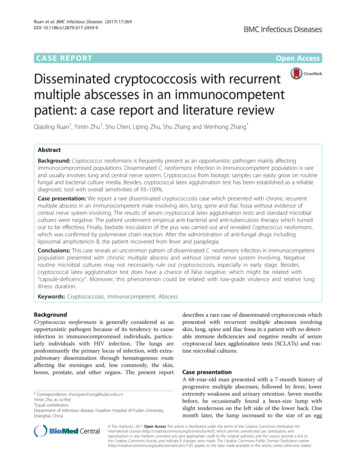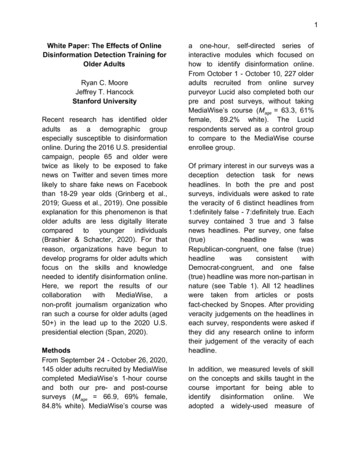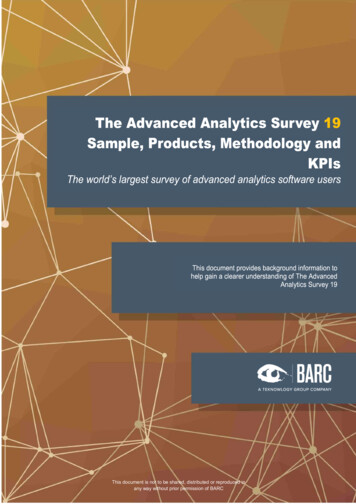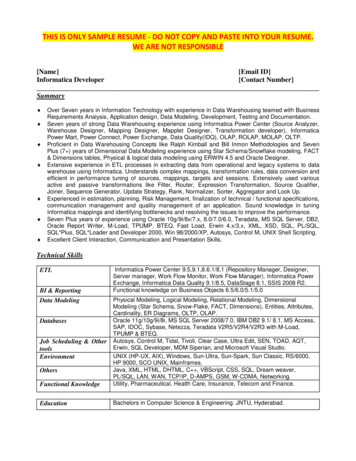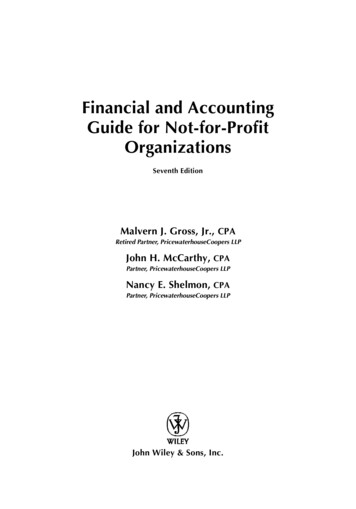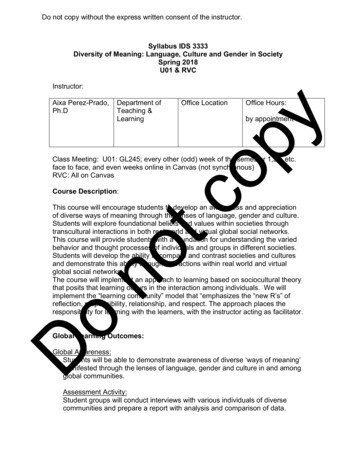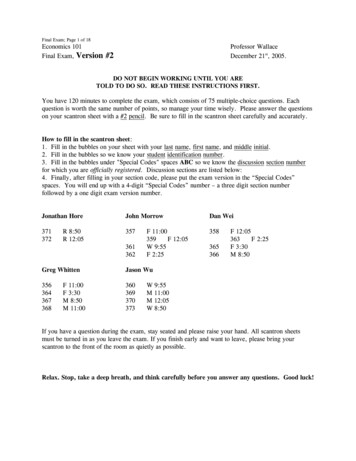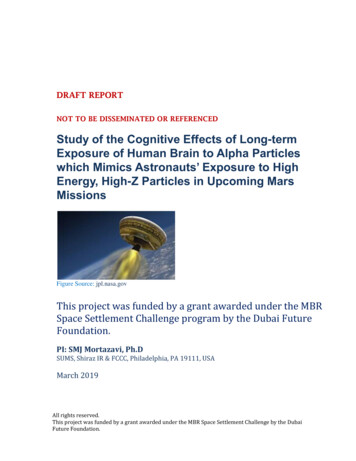
Transcription
DRAFT REPORTNOT TO BE DISSEMINATED OR REFERENCEDStudy of the Cognitive Effects of Long-termExposure of Human Brain to Alpha Particleswhich Mimics Astronauts’ Exposure to HighEnergy, High-Z Particles in Upcoming MarsMissionsFigure Source: jpl.nasa.govThis project was funded by a grant awarded under the MBRSpace Settlement Challenge program by the Dubai FutureFoundation.PI: SMJ Mortazavi, Ph.DSUMS, Shiraz IR & FCCC, Philadelphia, PA 19111, USAMarch 2019All rights reserved.This project was funded by a grant awarded under the MBR Space Settlement Challenge by the DubaiFuture Foundation.
Final ReportResearch Team Members:1. SMJ Mortazavi,Ph.D2. SMT Razavi Toosi, Ph.D3. P. Roshan-Shomal, M.Sc4. Seyed Alireza Mortazavi, Intern5. A. Kaveh, M.Sc6. G. Mortazavi, DDS1MBR ProjectPrincipal InvestigatorCo-InvestigatorExecutive ManagerLiterature ReviewProject CoordinatorLiterature ReviewThis project was funded by a grant awarded under the MBR Space Settlement Challenge by the Dubai FutureFoundation.
Final ReportMBR ProjectDubai Future FoundationMBR Space Settlement Challenge ProgramTable of Contents:BackgroundSpace EnvironmentThe Importance of Cognitive Health in Deep Space MissionsCognitive Effects of Exposure to High LET RadiationCan Radioadaptation Decrease the Cognitive Effects of HZE particlesThe Analogy of Radium-226 Absorption in BrainThe Shortcoming of Radium-226 AnalogyMethods Used in This StudyMain results or outputsDiscussionObstacles or changes of direction during the projectPotential impact and opportunities for implementation of the resultsConclusion and next steps Error! Bookmark not defined.ReferencesAppendixMBR Space ProjectCopyright 2019SMJ Mortazavi, Ph.DPage 22
Final ReportMBR ProjectBackgroundAstronauts are exposed to unique environmental factors such as space radiationand microgravity. These factors can be considered as a major threat to the DNAintegrity of living organisms(1). Space radiation includes galactic cosmic rays(GCR) and protons released from large solar particle events (SPEs). The maincomponents of GCR (2)are shown in Figure1.HZE particles have a large crosssection for interaction with low atomic number nuclei, hence, the most effectivepractical shields against HZE are hydrogen-rich polymers(3).On Earth, all living organisms have evolved efficient methods to confront DNAdamages. However, it’s believed that the unique space environmental factors canaffect the efficiency of DNA repair and cause accumulation of severe DNAlesions (e.g. double strand breaks (DSB), chromosome aberrations (CA),micronucleus formation (MN)(1). Risk of acute radiation syndromes (ARS) due tosolar particle events (SPEs), risk of cardiovascular disease and otherdegenerative tissue effects from radiation exposure and secondary spaceflightstressors as well as the risk of radiation carcinogenesis should be clearlyaddressed before any long-term mission(4). Besides acute radiation syndromeand cancer, there are also concerns over the potential behavioral and cognitiveimpairments caused by exposure of the astronauts’ central nervous system(CNS) to high levels of space radiation (the possibility of developing dementiaand other motor neuron diseases).Space EnvironmentSpace radiation environment is complex and includes contributions from galacticcosmic radiation (GCR) and solar particle events (SPEs). The complexity of thisradiation environment is summarized in Table 1 (Appendix ) and includeselectrons, protons, light ions, heavy ions, charged target fragments, andneutrons(5, 6). These radiation types have a wide range of energies and interactwith the spacecraft shell to produce a wealth of secondary radiation typesincluding pions, muons, photons, and electromagnetic and hardronic cascaderadiation(7-9).Although HZE consist 1-2% of the GCR, these energetic heavy ions contributeabout 50% of the long-term radiation dose and pose a significant biologicalhazard that increases the risk of cancer in astronauts.3This project was funded by a grant awarded under the MBR Space Settlement Challenge by the Dubai FutureFoundation.
Final ReportMBR ProjectFigure 1. The main components of GCR and SPE. (2)The Importance of Cognitive Health in Deep Space MissionsAstronauts’ exposure to radiation is different from exposure to radiation on theEarth. Concerns over the astronauts’ exposure are not limited to cancer. Besidescancer and acute radiation syndrome, there are also concerns over the potentialbehavioral and cognitive impairments caused by exposure of the astronauts’central nervous system to high levels of space radiation (risk of dementia andother motor neuron diseases). Therefore, potential behavioral and cognitiveimpairments caused by astronauts’ brains exposure to high levels of spaceradiation and the possibility of developing dementia and other motor neurondiseases are getting more attention. Dr. John Boice, President of NCRP and hiscolleagues in their recent paper (10) address this importance “NASA is interested thatradium, deposited in the brain, releases high-LET alpha particles - the only human analogue, thoughlimited, for high energy, high-Z particles traveling through space that might affect astronauts on Marsmissions”. When these exposures are long-term, they would be much moreimportant for risk assessment in Mars missions, so Boice et al. also state " Thehuman brain exposed for years to alpha particles may be relevant to a Mars mission in contrast with themouse brain exposed to heavy ions for a few minutes ". Interestingly, both Boice and NASAignored this fact that radium as well as many other alpha emitters tend toaccumulate in the bone, and the alpha particles whose energy is typically 5MeV have a very short range (10s of µm), the radiation dose due to the alphaemitters would be localized to volumes near the cranium rather than beinguniformly distributed throughout the cerebral and cerebellar parenchyma.Therefore, normally the dose to the functional parts of the brain are not likely tobe significant, even with higher uptakes of the radium or other alpha-emittingisotopes in the cranium. In this light, in this project only residents with calciumrich diet will be selected for the study.Some evidence shows that even exposure to low doses of charged particles canlead to persistent oxidative stress and cognitive impairment over protracted timesMBR Space ProjectCopyright 2019SMJ Mortazavi, Ph.DPage 44
Final ReportMBR Project(11). It has been shown that whole-body exposure to mission relevant doses aslow as 150-200 mGy of 1 GeV/nucleon (56) Fe particles, can cause impairedattentional set-shifting performance in socially mature rats (12). In this light,scientists are convinced that even at low levels of exposure, cognitive deficitsoccur and persist (13). Interestingly, some findings show that if the radiation doseis reduced down to 100 mGy, impairment can be prevented(12). Neurogenesis,the process of generating new brain cells can be prevented by exposure toionizing radiation. Therefore, when radiation damages neurons or supportingcells, development of new cells, at least at the level biological systems need tominimize or eliminate the damage, will be impaired. This interruption may causeproblems such as cognitive impairment and memory deficits.Cognitive Effects of Exposure to High LET RadiationFindings of recent studies propose that exposure to space environment mayinduce changes in neuronal structure, cellular function, oxidative response,mitochondrial function and metabolism. These alterations may cause tissue injuryand late neurodegeneration (14). It has long been known that exposing rodentsto HZE particles disrupts the dopaminergic system function and the behaviorsmediated by this system. Cognitive impairment in irradiated rats compared to thecontrol group was demonstrated in some studies. Studies conducted suggeststhat increased release of reactive oxygen species (ROS) can be involved in theinduction of radiation-induced cognitive deficits (15).A recent study shows that in male cohorts a single exposure to GCR can inducelong-term behavioral deficits characterized by diminished social interaction,increased anxiety like phenotype, impaired recognition memory. However, GCRexposures did not cause any behavioral deficits in female cohorts. These findingsshowed promising cellular and molecular intervention targets that reduce GCRinduced chronic cognitive deficits(16).Oxygen molecules can penetrate the normal shielding of spacecrafts, potentiallyimpacting 25% of the hippocampus. Thus, to assess whether 16O-particles caninduce behavioral deficit and histological alterations in rodents, mice wereexposed to particulate 16O particles at doses of 0 and 0.05 Gy. This studyshowed that exposure to 0.05 Gy significantly impaired novel object recognition.However, no effect on short term memory and exploratory activity in the Y-mazewas found. This study provided evidence that exposure to space radiation maycause detrimental effects on mature neurons linked to hippocampal learning andmemory(17).To study the effects of Iron (56Fe) ions on the risk of Alzheimer's disease (AD), 6months after exposure to 10 and 100 cGy56Feradiation at 1 GeV/µ, cognitiveabilities were studied in an animal model. Not only mice showed decreasedcognitive abilities, acceleration of Aβ plaque pathology was observed in male5This project was funded by a grant awarded under the MBR Space Settlement Challenge by the Dubai FutureFoundation.
Final ReportMBR Projectmice. This study showed that HZE particle radiation can increase the pathologyof Aβ plaque in a mouse model of AD (18).In another study, to compare the effects of partial or whole-body exposures to¹⁶O particles on cognitive performance, three groups of rats were exposed to ¹⁶Oparticles (1,000 MeV/n). The exposures of the 1st, 2nd and 3rd groups were “headonly”, “body only”, and “total body”, respectively. Findings of this study showedthat the cognitive performance of the rats was significantly different in thesegroups. Given this consideration, the authored discussed that non-targetedeffects (e.g. bystander effect, genomic instability and adaptive response) of HZEparticles maybe involved in this phenomenon(19). The authors concluded thatcompared to what previously believed, astronauts may be at a greater risk ofcognitive deficits induced by exposure to HZE particles(19).Cognitive detriments associated with alterations in neuron morphology andplasticity are reported after exposure to heavy-ions either during radiotherapyor space missions(20, 21). A recent study shows that in exploratory classmissions, the LET of particles plays a key role in estimating the risk ofdeveloping a cognitive deficit(21). Interestingly, recent findings indicate that"mission-relevant" radiation doses of HZE particles (doses less than 20 cGy) canlead to impaired attentional set-shifting performance in animal models. However,the specific cognitive domains which can be impaired show some ion-specificalterations(22). Britten et al. have recently determined the effect of exposure to 520 cGy of 600 MeV/n 28Si particles on the performance ability of attentional setshifting ability in male retired breeder Wistar rats 3 months after exposure. Theirfindings showed that these exposures, in all doses, caused a significantimpairment(22).The importance of study of brain exposure to alpha particles emitted fromsources such as radium is well documented now. Dr. John Boice, President ofthe National Council on Radiation Protection and Measurements (NCRP) and hiscolleagues have recently published a paper that states “NASA is interested thatradium, deposited in the brain, releases high-LET alpha particles - the onlyhuman analogue, though limited, for high energy, high-Z particles (galacticcosmic rays) traveling through space that might affect astronauts on Marsmissions”. In long-term space missions, the combined effect of radiation andmicrogravity affects the astronauts’ health.Can Radioadaptation Decrease the Cognitive Effects of HZEparticlesIt has long been known that a pre-exposure to a low level stressor (e.g.low dose radiation) can induce an adaptive response by stimulating the defensemechanisms such as increasing antioxidant levels, reducing the endogenousDNA damage, increasing DNA repair capacity, and increasing apoptosis ofMBR Space ProjectCopyright 2019SMJ Mortazavi, Ph.DPage 66
Final ReportMBR Projectdamaged cells (23). A NASA report published in 2016 refers to reports about theimportance of radioadaptation in deep space missions including our 2003 reportand states that it would be realistic to expect that astronauts’ cells will beexposed to multiple hits of protons before being traversed by an HZE particle“There have been several studies performed that indicate an adaptive response tolow-dose ionizing radiation can provide a level of protection against future exposures(Bhattacharjee and Ito 2001;(24) Mortazavi et al. 2003;(25) Elmore et al. 2008;(26)Rithidech et al. 2012(27)). This may be particularly important for understanding risksin the space environment because the GCR environment is comprised predominantlyof protons, and it is realistic to expect that cells will be exposed to multiple hits ofprotons prior to being traversed by an HZE particle”. (28). Moreover, a paperauthored by thirteen scientists from different countries (US, Canada, UK, Russia,and Belgium) re-confirmed the cardinal role of biological protection amongradiation risk reduction strategies for astronauts participating in space missions(29). The authors of this paper report that understanding how exposure to highLET radiation can induce radioadaptive responses. We have recently discussedthe details of our proposed model of adaptive response for protecting astronautsin deep space.As shown in Figure 1, during the mission, chronic exposure to elevatedlevels of galactic cosmic radiation (GCR) can considerably decrease radiationsusceptibility and better protect astronauts against the unpredictable exposure tosudden and dramatic increase in flux due to solar particle events (SPE) (30).7This project was funded by a grant awarded under the MBR Space Settlement Challenge by the Dubai FutureFoundation.
Final ReportMBR ProjectFigure 1. Our proposed model of radioadaptation and its key role in protecting the astronauts against high levelsof space radiation. Based on this model, during the deep space mission, chronic exposure to elevated levels ofGCR can considerably decrease radiation susceptibility of astronauts and better protect them against theunpredictable exposure to sudden and dramatic SPEs (30).Although exposure to high doses of ionizing radiation can cause formation ofreactive oxygen species (ROS), oxidative stress and neuro-inflammation, a largebody of evidence also shows that exposure to low dose/dose rates of ionizingradiation can lead to mitigation of tissue damage through antioxidant defensemechanisms(31). Therefore, possible protective consequences of low doseradiation in preventing the pathogenesis of AD can be observed throughmechanisms such as restoring the myelin sheath and preventingneurodegeneration caused by oxidative stress(31). In spite of its importancethere is not any consistent evidence showing that radioadaptation can decreasethe cognitive effects of HZE particles.The Analogy of Radium-226 Absorption in BrainThe importance of study of brain exposure to alpha particles emitted fromsources such as radium is well documented now. Dr. John Boice, President ofthe National Council on Radiation Protection and Measurements (NCRP) and hisMBR Space ProjectCopyright 2019SMJ Mortazavi, Ph.DPage 88
Final ReportMBR Projectcolleagues have recently published a paper that states “NASA is interested thatradium, deposited in the brain, releases high-LET alpha particles - the onlyhuman analogue, though limited, for high energy, high-Z particles (galacticcosmic rays) traveling through space that might affect astronauts on Marsmissions”. In long-term space missions, the combined effect of radiation andmicrogravity affects the astronauts’ health.We have previously reported extraordinary levels of Ra-226 in some inhabitedareas. Residents of high background radiation areas of Ramsar are living in andconsuming locally grown foods from districts where the soil has high levels of Ra226. The uptake of Ra-226 by vegetation grown in these areas has beenpreviously investigated. Altogether, these data show that our project can providethe best human brain radiation exposure analogue for upcoming Mars missions.The Shortcoming of Radium-226 AnalogyThe importance of study of brain exposure to alpha particles emitted fromsources such as radium is well documented now. Dr. John Boice, President ofthe National Council on Radiation Protection and Measurements (NCRP) and hiscolleagues have recently published a paper that states “NASA is interested thatradium, deposited in the brain, releases high-LET alpha particles - the onlyhuman analogue, though limited, for high energy, high-Z particles (galacticcosmic rays) traveling through space that might affect astronauts on Marsmissions”. In long-term space missions, the combined effect of radiation andmicrogravity affects the astronauts’ health.9This project was funded by a grant awarded under the MBR Space Settlement Challenge by the Dubai FutureFoundation.
Final ReportMBR ProjectMethods Used in This StudyThis case-control study was carried out on the residents of the areas with higherthan-normal levels of natural radioactivity. Some inhabited parts of Ramsar, acoastal city in North Iran, have extraordinary levels of Ra-226 due to thepresence of this radionuclide and its decay products, which are brought to theEarth's surface by hot springs (32, 33).1. Measurement of Background Gamma RadiationThe methods used for measuring background gamma radiation level arepreviously described in our publications(34). Briefly, we used a calibrated RDS110 (RADOS Technology, Finland) survey meter. This survey meter wasmounted on a tripod approximately 1 m above the ground inside the 63 dwellingslocated in high and normal background radiation areas of Ramsar normal and(17 houses from NBRAs and 46 houses from HBRAs). The readings wererecorded every 10 minutes for 30 minutes. Then, the mean of 3 readings wascalculated. In each house measurements were performed in locations as follows:1. Bedroom2. Dining Room3. Vegetable Yard4. Garden with citrus fruit trees2. Study of the Food FrequencyTo make sure that the participants have a calcium-rich diet, we used a standardfood frequency questionnaire (FFQ). The validity and reliability of FFQ waspreviously approved. This questionnaire which includes about 90 food items wasused by experienced interviewers to estimate dietary intakes. The FFQ used inthis study has multiple-choice response about the frequency of intake per day,week, month and year. The national nutrient databank of US Department ofAgriculture's (USDA) was used for reference values.3. Reaction TimeThe method used for measuring reaction time is previously described in ourpublications(35). Briefly, visual reaction time (VRT) of all participants wasrecorded using a simple blind computer-assisted-VRT test. Right-handedindividuals participated in this test.MBR Space ProjectCopyright 2019SMJ Mortazavi, Ph.DPage 1010
Final ReportMBR Project4. Working Memory and Computational AbilityA modified Wechsler Memory Scale (WMS) test was used in this study. WMS isa neuropsychological test designed to measure different memory functions inindividuals at ages 16-90. This test is made up of multiple subtests (e.g. digitspan, letter-number sequencing).5. Radium Ingestion IndexPrevious studies performed in Ramsar shows that the concentration of 226Ra(mBq/kg wet weight) in leafy vegetables (other than tea) is about 3 times higherthan that of citrus fruits. Moreover, consumption of citrus fruits (gram vs gram)was much higher than leafy vegetables in
Final Report MBR Project 5 This project was funded by a grant awarded under the MBR Space Settlement Challenge by the Dubai Future Foundation. (11). It has been shown that whole-body exposure to mission relevant doses as low as 150-200 mGy of 1
